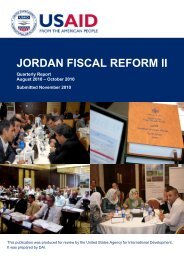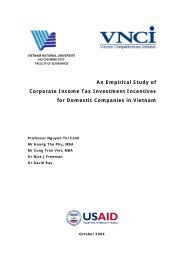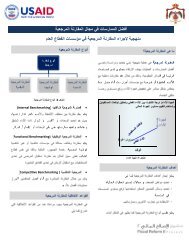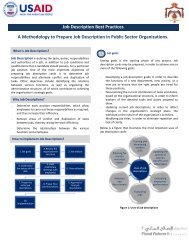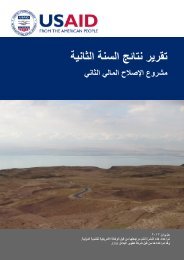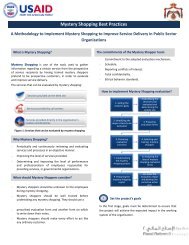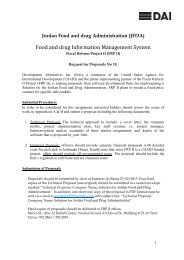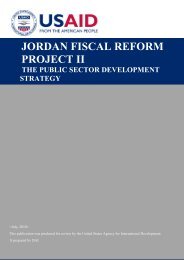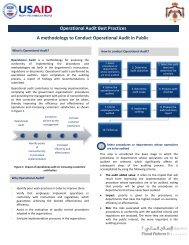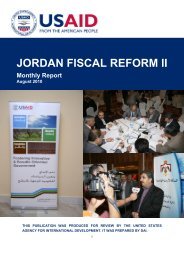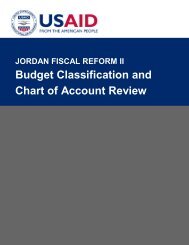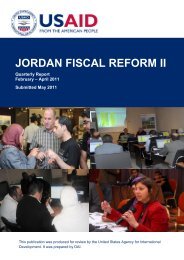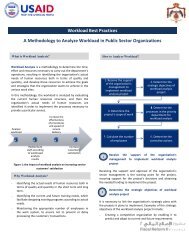Integrated Financial Management Information Systems: A ... - Frp2.org
Integrated Financial Management Information Systems: A ... - Frp2.org
Integrated Financial Management Information Systems: A ... - Frp2.org
You also want an ePaper? Increase the reach of your titles
YUMPU automatically turns print PDFs into web optimized ePapers that Google loves.
PART 2: COUNTRY CASES<br />
This section briefly covers some country examples to demonstrate different approaches to IFMIS<br />
implementation; some of the common features and problems faced; and, how similar problems can be<br />
avoided or resolved. Some countries chosen were successes, while others have experienced or may<br />
continue to experience severe implementation challenges.<br />
SLOVAK REPUBLIC<br />
It is very hard to emulate the rapid success of the Slovak Republic’s IFMIS. Political will was a key<br />
driving force, but it was underpinned by a clearly defined strategy and timeframe. A clear<br />
understanding of what the government and its institutions required turned into a clear definition of<br />
what needed to be achieved, with a clear definition of the tools that were to be used. The system was<br />
defined, then acquired, tested, configured and “switched on” in time for the beginning of the planned<br />
fiscal year. The result was a system that, in its basic form, was efficient enough to pay for the<br />
investment in less than nine months of operation.<br />
The first step in this process was to undertake a needs assessment. This established the basic<br />
functions for the new Ministry of Finance IFMIS, a system that was to serve as many Governmentrelated<br />
client organizations as feasible. The needs assessment also set out other basic requirements for<br />
the new system. These included, inter alia:<br />
It should function in effect as a “bank” for all users,<br />
It should have the functionality to manage budgets, record financial transactions, and manage<br />
financial resources,<br />
The accounting framework would be International Accounting Standards (IAS), now<br />
International <strong>Financial</strong> Reporting Standards (IFRS),<br />
The Treasury would centralize control of cash in a Treasury Single Account (TSA), transferring<br />
funds to settle payments as they come due,<br />
After careful evaluation of available software packages and their ability to meet these requirements,<br />
the system chosen was composed of three basic off-the-shelf packages:<br />
A General ledger application – package chosen SAP<br />
Client banking software – package chosen QBSW<br />
Treasury management and trading software – package chosen TREMA<br />
A request for tender documents was then drafted and published and various bidders submitted<br />
proposals for integrating the system. The tender process itself did not go as smoothly as the overall<br />
implementation. The contract was initially awarded to one firm, and then swiftly withdrawn after a<br />
bribery scandal was exposed in the press. Despite a series of appeals, the contract was eventually<br />
awarded to the runner-up, Hewlett Packard, which set out to install the selected COTS packages on<br />
HP’s hardware platform.<br />
As a first task, the integration team established a steering committee to oversee the entire process.<br />
The team then designed a system architecture that would link all the information the system needed to<br />
handle into one structure. This figure below shows the basic system architecture.<br />
16 INTEGRATED FINANCIAL MANAGEMENT INFORMATION SYSTEMS: A PRACTICAL GUIDE



